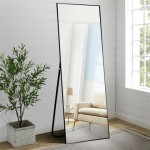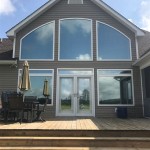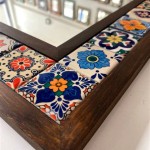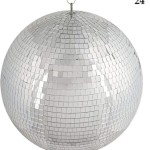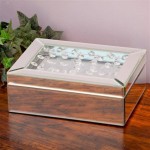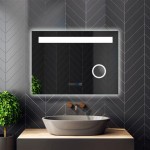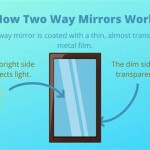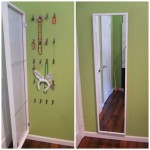Do Mirrors Make You Look Bigger or Smaller?
The perception of one’s body image in a mirror is a complex interplay of optics, psychology, and environmental factors. The question of whether mirrors make individuals appear bigger or smaller does not have a simple "yes" or "no" answer. Instead, it depends on several variables that influence how the human eye and brain interpret the reflected image.
Understanding the science behind mirrors provides a foundational understanding. A standard mirror consists of a sheet of glass with a reflective coating, typically aluminum or silver, applied to its back surface. Light rays striking the mirror are reflected, adhering to the law of reflection: the angle of incidence equals the angle of reflection. This creates a virtual image behind the mirror's surface that appears to be the same size and distance away as the object in front of it. However, this idealized scenario often deviates in real-world conditions.
Several factors can contribute to a discrepancy between the true size and the perceived size reflected in a mirror. These include variations in mirror quality, the distance between the observer and the mirror, the lighting conditions within the room, and the psychological state of the individual observing the reflection.
Mirror Quality and Distortion
The quality of the mirror significantly impacts the accuracy of the reflection. High-quality mirrors have a perfectly flat surface and a uniform reflective coating, minimizing distortion. However, cheaper mirrors may exhibit subtle imperfections, such as warps or uneven surfaces. These imperfections can subtly alter the angles at which light is reflected, leading to a distorted image. The effect of these distortions can vary, making individuals appear either slightly broader or slimmer than their actual size.
Specifically, a concave mirror, which curves inward, acts as a magnifying glass and can make objects appear larger. Conversely, a convex mirror, which curves outward, creates a wider field of view but compresses the image, making objects appear smaller. While standard household mirrors are designed to be flat, minor imperfections can introduce similar, albeit less pronounced, effects.
The thickness of the glass can also play a role. Thicker glass is less prone to warping, resulting in a more accurate reflection, while thinner glass is more susceptible to bending, potentially leading to distortion. The manufacturing process also influences the mirror's quality. Imperfect polishing or uneven coating application can introduce subtle irregularities that are not immediately visible but can affect the reflected image.
Furthermore, the age of the mirror can affect its reflective properties. Over time, the reflective coating can degrade, leading to a less clear and potentially distorted image. This degradation can be more pronounced in humid environments or if the mirror is not properly maintained.
Distance and Perspective
The distance between an individual and the mirror is a crucial determinant of perceived size. When standing close to a mirror, the reflection tends to magnify certain features, particularly those closest to the mirror, such as the face and upper body. This proximity effect can lead to a perception of increased size or bulk.
Conversely, when standing further away from the mirror, the entire body is captured in the reflection, providing a more comprehensive view. This wider perspective often results in a perception of reduced size, as the individual sees themselves in proportion to their surroundings. The further away the observer stands, the smaller the reflection generally appears.
This phenomenon is related to the principles of perspective. Objects closer to the observer appear larger, while objects further away appear smaller. The mirror's reflection mimics this effect, changing the perceived size based on the distance between the individual and the reflective surface.
Furthermore, the angle at which one views the reflection also impacts perception. Looking at oneself from a low angle can make one appear taller and slimmer, while viewing oneself from a high angle can make one appear shorter and broader.
Lighting and Color
Lighting conditions in the room significantly impact how one perceives their reflection. Bright, direct light can cast harsh shadows, accentuating imperfections and making the body appear more defined, which some may interpret as larger. Conversely, dim or diffused lighting can soften shadows and create a more flattering, and potentially slimming, effect.
The color temperature of the light also plays a crucial role. Cool, bluish light tends to enhance cool tones in the skin and can sometimes create a more clinical or unflattering appearance. Warm, yellowish light, on the other hand, tends to create a more inviting and flattering appearance, often making the body appear smoother and less defined.
The color of the surrounding walls and objects can also influence perception. Dark-colored walls can absorb light, making the reflection appear darker and potentially smaller. Light-colored walls, on the other hand, reflect more light, brightening the reflection and potentially making the individual appear larger.
Furthermore, the placement of light sources in relation to the mirror can affect the shadow patterns. Light sources placed directly in front of the mirror can minimize shadows, creating a more uniform and potentially flattering appearance. Light sources placed to the side can cast shadows that emphasize certain features, potentially leading to a perception of increased size or bulk.
Psychological Factors and Body Image
Beyond the physical and optical aspects, psychological factors heavily influence how individuals perceive their reflection. Body image, or the subjective picture one has of their physical appearance, is a powerful determinant of whether someone perceives themselves as bigger or smaller in a mirror.
Individuals with a negative body image are more likely to focus on perceived flaws and imperfections, leading them to overestimate their size or weight. This negative self-perception can be amplified when looking in a mirror, as the reflection provides a visual representation of their perceived shortcomings.
Conversely, individuals with a positive body image are more likely to focus on their positive attributes and downplay perceived flaws. This positive self-perception can lead them to view their reflection more favorably, potentially seeing themselves as smaller or more attractive than they objectively are.
Social and cultural influences also play a significant role in shaping body image. Media portrayals of idealized body types can create unrealistic expectations and contribute to feelings of inadequacy. Individuals who internalize these unrealistic standards may be more likely to perceive themselves as bigger than they actually are.
Furthermore, past experiences and memories can influence how one perceives their reflection. For example, if someone experienced negative comments about their appearance in the past, they may be more sensitive to perceived flaws and imperfections, leading them to perceive themselves as bigger in the mirror.
The time of day and mood can also affect body image perception. Individuals may feel more self-conscious about their appearance in the morning, after waking up, or when they are feeling stressed or anxious. Conversely, they may feel more confident and positive about their appearance after exercising, receiving compliments, or engaging in activities that boost their self-esteem.
In conclusion, the perception of size in a mirror is not a straightforward reflection of reality. Optical principles, mirror quality, environmental conditions, and, most significantly, the individual's psychological state all contribute to the final perceived image. While a mirror physically reflects an image with a size that adheres to optical laws, the brain's interpretation of that image is subject to a variety of influencing factors, resulting in a subjective experience that may or may not align with objective reality. Understanding these factors can help individuals approach their reflections with a more informed and self-aware perspective.

Proof You Do Look Diffe In Every Changing Room Mirror Amanda Platell Writes Daily Mail
Why Do We Look Fitter In Gym Mirrors Quora

Fuming Woman Accuses High Street Chain H M Of Using Curved Mirrors That Make Customers Look Fatter The Sun

Do Mirrors Make You Look Bigger

Why Do I Look Diffe In Mirrors 5 Common Reasons

Are Skinny Mirrors Being Used In Popular Retailers Dressing Rooms I Decided To Find Out

Why Do I Look Diffe In Mirrors 5 Common Reasons

Fitness Expert Showcases How Diffe Fitting Room Mirrors Can Make You Look Completely Daily Mail
Why Do We Look Fitter In Gym Mirrors Quora

Here S How Fitting Room Mirrors Make You Look A Lot Better Than Do
